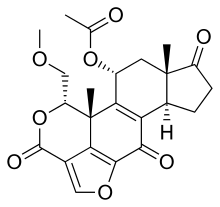Wortmannin
Wortmannin, a steroid metabolite of the fungi Penicillium funiculosum, Talaromyces wortmannii, is a non-specific, covalent inhibitor of phosphoinositide 3-kinases (PI3Ks). It has an in vitro inhibitory concentration (IC50) of around 5 nM, making it a more potent inhibitor than LY294002, another commonly used PI3K inhibitor. It displays a similar potency in vitro for the class I, II, and III PI3K members although it can also inhibit other PI3K-related enzymes such as mTOR, DNA-PKcs, some phosphatidylinositol 4-kinases, myosin light chain kinase (MLCK) and mitogen-activated protein kinase (MAPK) at high concentrations [1],[2] Wortmannin has also been reported to inhibit members of the polo-like kinase family with IC50 in the same range as for PI3K.[3] The half-life of wortmannin in tissue culture is about 10 minutes due to the presence of the highly reactive C20 carbon that is also responsible for its ability to covalently inactivate PI3K. Wortmannin is a commonly used cell biology reagent that has been used previously in research to inhibit DNA repair, receptor-mediated endocytosis and cell proliferation.[4][5]
 | |
| Identifiers | |
|---|---|
3D model (JSmol) |
|
| ChEMBL | |
| ChemSpider | |
| ECHA InfoCard | 100.112.065 |
PubChem CID |
|
| UNII | |
CompTox Dashboard (EPA) |
|
| |
| |
| Properties | |
| C23H24O8 | |
| Molar mass | 428.437 g·mol−1 |
| Melting point | 238 to 242 °C (460 to 468 °F; 511 to 515 K) |
Except where otherwise noted, data are given for materials in their standard state (at 25 °C [77 °F], 100 kPa). | |
| Infobox references | |
Phosphoinositide-3-kinase
Phosphoinositide-3-kinase (PI3K) activates an important cell survival signaling pathway, and constitutive activation is seen in ovarian, head and neck, urinary tract, cervical and small cell lung cancer. PI-3-K signaling is attenuated by the phosphatase activity of the tumor suppressor PTEN that is absent in a number of human cancers. Inhibiting PI-3-K presents the opportunity to inhibit a major cancer cell survival signaling pathway and to overcome the action of an important deleted tumor suppressor, providing antitumor activity and increased tumor sensitivity to a wide variety of drugs.
Wortmannin is a known and potent PI3K inhibitor; as such, it was shown to have detrimental influence on memory and impair spatial learning abilities.[6]
Derivates
In order to stabilize the Wortmannin molecule while not losing its therapeutic effect, numerous derivates were synthesized from Wortmannin[7]
PX-866
One of these, PX-866 (now "Sonolisib"), has been shown to be a novel, potent, irreversible, inhibitor of PI-3 kinase with efficacy when delivered orally. PX-866 was put in a phase 1 clinical trial by Oncothyreon company.[8][9][10] The clinical development plan for PX-866 includes both standalone and combination therapy in major human cancers.[11] In 2010 PX-866 was starting 4 phase II trials for solid tumours.[12] The company gave an update on its phase 2 trials in Jun 2012.[13] Phase 1 results (with docetaxel) published Aug 2013.[14] In July 2014 published results of a phase 2 trial (for NSCLC) concluded : "The addition of PX-866 to docetaxel did not improve PFS, response rate, or OS in patients with advanced, refractory NSCLC without molecular preselection".[15] In Sept 2015 as Phase 2 trial for recurrent glioblastoma reported not meeting its primary endpoint.[16]
References
- Vanhaesebroeck B et al., (2001) Synthesis and function of 3-phosphorylated inositol lipids. Annu Rev Biochem.
- Ferby I et al., 1996. Adv Exp Med Biol. PAF-induced MAPK activation is inhibited by wortmannin in neutrophils and macrophages.
- Liu Y et al., 2007. J. Biol Chem 282(4): 2505-11 Polo-like Kinases Inhibited by Wortmannin: Labeling Site and Downstream Effects
- Liu Y, Shreder KR, Gai W, Corral S, Ferris DK, Rosenblum JS. Wortmannin, a widely used phosphoinositide 3-kinase inhibitor, also potently inhibits mammalian polo-like kinase. Chem Biol. 2005;12:99–107.
- Sang-Hoon Kim, Young-Woo Jang, Patrick Hwang, Hyun-Jung Kim, Gi-Yeon Han, and Chan-Wha Kim; The reno-protective effect of a phosphoinositide 3-kinase inhibitor wortmannin on streptozotocin-induced proteinuric renal disease rats; Exp Mol Med. 2012 Jan 31; 44(1): 45–51.
- Molecular Psychiatry (2003) 8, 217–224; Phosphatidylinositol 3-kinase: a molecule mediating BDNF-dependent spatial memory formation M Mizuno
- The discovery of PX-866: Molecular pharmacology and antitumor activity of PX-866, a novel inhibitor of phosphoinositide-3-kinase signaling, Nathan T. Ihle et al., Mol Cancer Ther. 2004;3:763-772
- Howes, AL; Chiang, GG; Lang, ES; Ho, CB; Powis, G; Vuori, K; Abraham, RT (2007). "The phosphatidylinositol 3-kinase inhibitor, PX-866, is a potent inhibitor of cancer cell motility and growth in three-dimensional cultures". Molecular Cancer Therapeutics. 6 (9): 2505–14. doi:10.1158/1535-7163.MCT-06-0698. PMID 17766839.
- PX-866 June 2010
- Clinical trial number NCT00726583 for "Phase I Trial of Oral PX-866" at ClinicalTrials.gov
- Oncothyreon initiates Phase 1 trial of PX-866 cancer compound. 17/06/2008 lifesciencesworld news
- "ONTY Starts Four-Phase II Trial Program With Its Oral PI3K Inhibitor". 4 Nov 2010.
- Oncothyreon Announces Presentation of PX-866 Clinical Data at American Association of Clinical Oncology Annual Meeting. June 2012
- A multicenter phase 1 study of PX-866 in combination with docetaxel in patients with advanced solid tumours
- Levy, B; Spira, A; Becker, D; Evans, T; Schnadig, I; Camidge, DR; Bauman, JE; Hausman, D; Walker, L; Nemunaitis, J; Rudin, CM; Halmos, B; Bowles, DW (2014). "A randomized, phase 2 trial of Docetaxel with or without PX-866, an irreversible oral phosphatidylinositol 3-kinase inhibitor, in patients with relapsed or metastatic non-small-cell lung cancer". J Thorac Oncol. 9 (7): 1031–5. doi:10.1097/JTO.0000000000000183. PMID 24926548.
- Pitz, MW; Eisenhauer, EA; MacNeil, MV; Thiessen, B; Easaw, JC; Macdonald, DR; Eisenstat, DD; Kakumanu, AS; Salim, M; Chalchal, H; Squire, J; Tsao, MS; Kamel-Reid, S; Banerji, S; Tu, D; Powers, J; Hausman, DF; Mason, WP (2015). "Phase II study of PX-866 in recurrent glioblastoma". Neuro Oncol. 17 (9): 1270–4. doi:10.1093/neuonc/nou365. PMC 4588751. PMID 25605819.
External links
- Wortmannin bound to proteins in the PDB